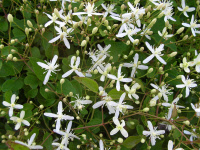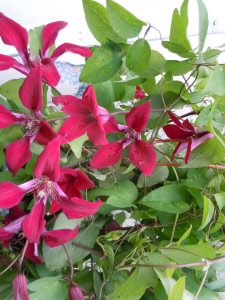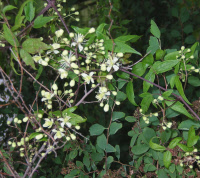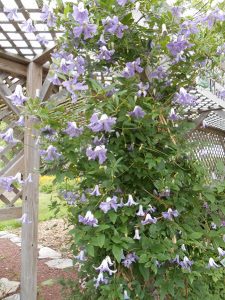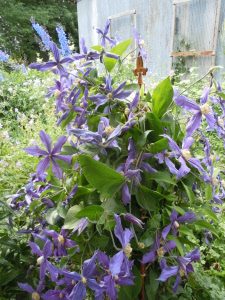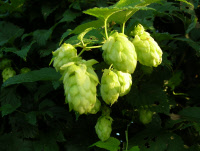Vines
Showing 9–14 of 14 results
-
Clematis ternifolia Sweet Autumn clematis Z 4-8
Fragrant, small white blossoms smother this vigorous vine
Fragrant, small white blossoms smother this vigorous vine in September and October.
Can not ship to: Alabama, Delaware, Florida, Georgia, Maryland, Nebraska, New York, North Carolina, South Carolina, Tennessee and Virginia.
Size: 15-20’ x 6-10’
Care: Sun moist well-drained soil mulched. Flowers on current year’s wood. Cut back in early spring to 6-8” above the soil.
Native: JapanThe genus Clematis was named by Dioscordes, physician in Nero’s army, from “klema” meaning climbing plant. In 1877 seeds of this vine sent from Russia to the Arnold Arboretum in Boston, then distributed to nurseries throughout America.
-
Clematis texensis ‘Gravetye Beauty’ Z 5-9
Small crimson-red bells dangle from July to September
Small crimson-red bells dangle from July to September
Size: 8’ x 3’
Care: Sun in humusy, fertile, moist well-drained soil. Mulch around the base. Flowers on current year’s stems so cut back to 6-9” in late winter or early spring.The genus Clematis was named by Dioscordes, physician in Nero’s army, from “klema” meaning climbing plant. The species 1st collected by the “Father of Texas botany,” Ferdinand Lindheimer in 1830’s. Max Leichtin of the Baden Garden sent Clematis texensis to Kew Botanic Garden near London in 1880’s. French nurseryman Francisque Morel sent this selection to William Robinson who named it for his English nursery at Gravetye Manor in 1914.
-
Clematis virginiana Virgin’s bower, Devil’s darning needles Z 4-8
July-September star-like white blossoms
July-September star-like white blossoms cover this vine – good for clambering up small trees.
Size: 12-20’ x 4’
Care: Sun to shade moist well-drained soil. Flowers on new stems so cut back in late winter or early spring to 6-8” above the ground.
Native: Nova Scotia to Georgia and as far west as Kansas, Wisconsin nativeThe genus Clematis was named by Dioscordes, physician in Nero’s army, from “klema” meaning climbing plant. One of 1st No. American plants sent to Europe – grew in Tradescant the Elder’s South Lambeth nursery in 1634. Grown by Jefferson at Monticello in 1807. Described by Breck in his 1851 book The Flower Garden: “The flowers are white borne upon cymes, and make a handsome appearance.” Cherokee mixed this plant with milkweed to remedy backaches. A root extract cured stomach aches, nervous conditions and kidney ailments. For the Iroquois powdered root fixed venereal disease sores and an extract of the stem brought on strange dreams. Pressed specimen in Emily Dickinson’s herbarium.
-
Clematis viticella ‘Betty Corning’ Z 3-9
Pendulous lavender trumpets
Pendulous lavender trumpets with bodacious flares bloom profusely, blooming machine all summer into fall.
Size: 8-10’ x 8’
Care: sun to shade in moist well-drained soil. Prune back to 1’ above ground in early spring.
Awards: Elisabeth Carey Miller Botanic Garden Great Plant Pick; Cary Award Distinctive Plants for New England; and England’s Royal Horticultural Society Award of Garden Merit.Selection of a cross between Clematis crispa and C. viticella, made in 1932 by Betty Corning.
-
Clematis x durandii Z 5-9
Big blue flowers from June to September
Big, deep indigo saucers – all summer into fall. The best short Clematis.
Size: 3-6' x 3'
Care: Full sun in moist well-drained to well-drained soil Prune back to a few inches above the ground in April. Needs staking or let it sprawl.
Awards: Elisabeth Carey Miller Botanical Garden Great Plant Pick.Cross of C. integrifolia and C. x Jackmanii, of garden origin. Hybrid from Durand in Freres France in 1874. William Robinson, father of mixed perennial borders, called this “effective and free.” (1933)
-
Humulus lupulus Hops Z 3-8
In August green turning to straw-colored papery hops dangle from this vigorous vine.
In August green turning to straw-colored papery hops dangle from this vigorous vine.
Size: 20' x 3'
Care: Sun to part shade in moist, humusy soil but tolerates dry shade.
Native: Europe
Wildlife Value: attracts Eastern comma & Red admiral butterfliesLupulus named for the Latin Lupis, meaning wolf “because the ancients had a notion that wolves hid themselves under this plant.” Gardeners Dictionary, 1768. Used for brewing since ancient times. Transported from continental Europe to England in 1524. Added to ale for flavor and as a preservative. In the late 1500’s Gerard claimed that hops seasoned ale and ”make it a physical drinke to keep the body in health, rather than an ordinary drinke for the quenching of our thirst… The buds or first sprouts which come forth in the Spring are used to be eaten in sallads… The floures are vsed to season Beere or Ale with, and too many do cause bitternesse thereof… The floures make bread light, and the lumpe to be sooner and easilier leauened, if the meale be tempered with liquor wherein they haue been boyled.” Russians crowned the heads of brides with its foliage to bring “joy, abundance and intoxication.” Others put dried hops into pillows to relieve insomnia. Imported to America by the mid 1600’s where it was used to provide shade and to make beer. Cherokee adopted hops to relieve pain caused by rheumatism. Grown by Jefferson.

